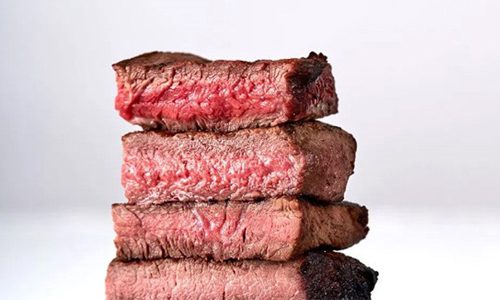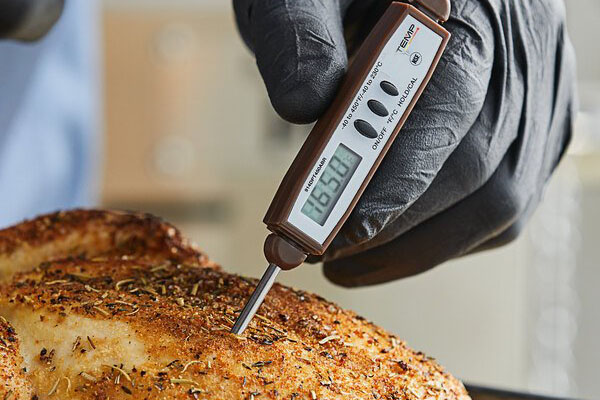Grilling is both an art and a science, and you must consider many factors when deciding to cook mouth-watering food. It is the best choice to have both taste and safe consumption.
Although many people will tell you that the best way is to simply look at the color of the meat and its juices (this may be a good way to tell if you know what you are looking for), it is simpler and does not need to open the lid from time to time to pay attention to the color of the food. The method is to measure the internal temperature with a thermometer. There are many types to choose from, and it is strongly recommended that you buy one to ensure that your meat is 100% safe to eat.
When you use the thermometer, please note that the internal temperature of the meat on the grill is different from that at rest. Usually it will be about 5 degrees higher, which is completely normal. The rest time can range from 3 minutes to 30 minutes, depending on how big your plate is and various other factors.

Below, you will find a list of different types and cuts of meat, as well as recommendations for the lowest temperature:
BEEF, LAMB OR VEAL
In terms of grilling, most beef, veal and lamb are served in the form of steaks, ribs or roasts. However, for smoking and other purposes, minced meat is also included.
CHOPS,
ROAST AND STEAKS
Beef, lamb and veal steaks, roasts or steaks have an internal temperature of at least 145°F after three minutes before they are completely safe to eat.
• Rare-the
internal temperature should be 120°F and the resting temperature should be
around 125°F
• Medium Rare-the
internal temperature should be 125°F and the resting temperature should be
around 130°
• Medium-the
internal temperature should be 130°F and the resting temperature should be
around 140°F
• Medium Well-The
internal temperature should be 145°F and the resting temperature should be
around 150°F
• Well-the
internal temperature should be 155°F and the resting temperature should be
around 160°F
MINCED
MEAT
Ground beef, lamb and veal must have an internal temperature of at least 160°F in order to be completely safe to eat.
• Rare-not
recommended
• Medium Rare-not
recommended
• Medium -the
internal temperature should be 140°F and the resting temperature should be
around 145°F
• Medium Well-the
internal temperature should be 150°F and the resting temperature should be
around 155°F
• Well-the
internal temperature should be 160°F and the resting temperature should be
around 165°F
PORK
Pork is one of the most commonly grilled foods. There are various cuts and types, including steak, shoulder, roast, ribs and ham. Of course, ribs are also common, but ribs are rarely designed to be “done” determined by internal temperature, so to make things simpler, I didn’t include them in this list.
CHOPS,
ROASTS AND STEAKS
Pork steaks, ribs or roasts must have an internal temperature of at least 145°F after three minutes to be completely safe to eat.
• Rare-the
internal temperature should be 125°F and the resting temperature should be
around 130°F
• Medium Rare-the
internal temperature should be 130°F and the resting temperature should be
around 135°
• Medium -the
internal temperature should be 140°F and the resting temperature should be
around 145°F
• Medium Well-The
internal temperature should be 150°F and the resting temperature should be
around 155°F
• Well-the internal temperature should be 155°F and the resting temperature should be around 160°F
SHOULDER
When smoking pork shoulder, the minimum temperature of the meat should reach 200°F. Kamado bbq smoker’s smoking temperature should be between 225-275°F. The time required depends on the size of the shoulder and the desired taste.
HAM
There are some subtle differences between smoked and grilled fresh and pre-cooked ham.
• Fresh Ham-the
internal temperature should reach 140°F and the resting temperature should
reach 145°F. If the temperature reaches at least 145°F after resting for three
minutes, it is safe to eat.
• Pre-cooked Ham-internal temperature should reach 135°F, resting temperature should reach 140°F. It is safe to eat if the temperature is at least 140°F after resting.
MINCED
MEAT
The internal temperature of minced pork is at least 160°F in order to be completely safe to eat.
• Rare-not
recommended
• Medium Rare-not
recommended
• Medium-the
internal temperature should be 140°F and the resting temperature should be
around 145°F
• Medium Well-The
internal temperature should be 150°F and the resting temperature should be
around 155°F
• Well -the
internal temperature should be 160°F and the resting temperature should be
around 165°F
POULTRY
Poultry, including chickens, ducks, geese and turkeys, must be cooked carefully to avoid any risk of disease. However, the process and temperature are the same whether it is cooked whole or cut. The meat should always be white, because undercooked poultry can be fatal.
When
the meat on the grill reaches 160°F, the meat is considered cooked. The
temperature at rest should be at least 165°F.
SEAFOOD
There are many different kinds of seafood (and many different sizes) that can be grilled, so there is no way to list a clear temperature guide. However, there are some general guidelines to indicate whether it has been completed.
• Finfish-The
recommended minimum temperature is 145°F. The fish should be opaque, firm, and
easy to separate with a fork.
• Scallops-The flesh
should be opaque, milky white and firm.
• Clams and
oysters-cook
until the shells open.
• Crab,
lobster and shrimp-cook until the meat is opaque and pearly
white.
VEGETABLE
We’ve discussed grilling vegetables before. Generally speaking, you can actually grill most vegetables without worrying about the temperature of using foil alone. However, if you do want to place them directly on the grill and need help determining the temperature, please keep some guidelines in mind.
• Artichoke – 350°F –
Cut in half and flatten the leaves, then brush with olive oil and salt
• Asparagus –
400-425°F – rolled in olive oil and sprinkled with salt
• Corn – 350°F –
Soaking and husking before placing on the grill
• Eggplant –
400-425°F – cut into circles and brushed with olive oil
• Leek-350
°F-Cut in half lengthwise, brushed with olive oil
• Mushrooms –
400-425°F – grilled whole and sliced as needed
• Onion –
400-425°F – Cut into rings and brush with olive oil, then salt and grill
• Peppers–
400-425°F – Brush with olive oil and cook for a few minutes on each side
• Zucchini-400-425°F-sliced,
brushed with olive oil and sprinkled with salt


通告: 10 Top Grilling Tips for Kamado Barbecue - Kamado Manufacturer for Large& Mini Kamado grill